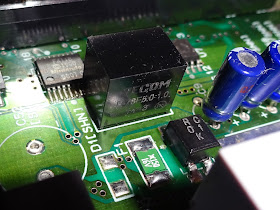Although this is smaller than the full size board, it has all the same chips, the RAM chips is now hidden under the ROM. It does have fewer DIP switches, so cannot be used to select individual ROMs or banks of RAM to replace, but for most users, it will only be used to enable all the upgrades and run at full capacity. The original versions are still available if you do need to diagnose faults.
The DIP switch options on this board are as follows:
- RAM enable, switch on to bypass the original RAM and use the full new 32K RAM
- ROM enable, switch on to bypass the original ROM and use one of the new ROM sets
- ROM select
- ROM select
- ROM select
These are supplied with ROMs for both the original range of Commodore PET machines without a CRTC chip (6545), starting with the original 2001, and the 2001N range, 30xx, and the 9" 40xx machines, includes the PET tester ROM, BASIC v1, BASIC v2 and the final BASIC v4.0. The other 4 ROM selections are for later CRTC based PETs, the 12" 4032 and 8032 machines. This includes 40 and 80 column ROM sets for Business and Normal keyboards (note you need 40 column hardware to use 40 column ROM sets and 80 column hardware needs 80 column ROMs).
The board is supplied with a double sided pin header socket which plugs into the bottom of the board and fits into the original CPU socket. The pins are thin like IC legs, so shouldn't cause any damage to the sockets, they are not the big square pins used for jumpers etc.
2022 Update: The PET ROM/RAM boards are still available from my SellMyRetro store
2024 Update: PET ROM/RAM Boards are back at my Tindie store


















